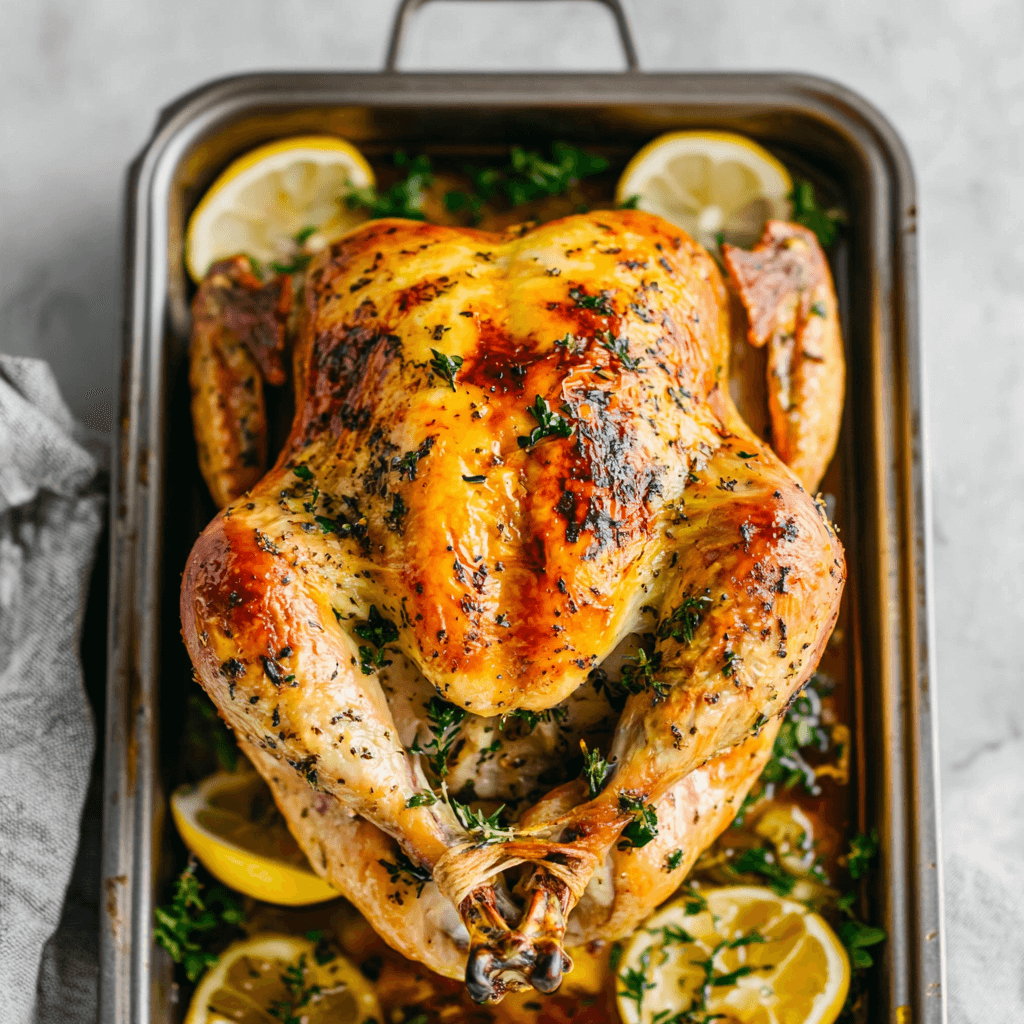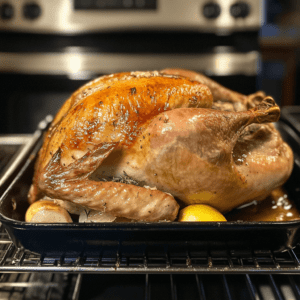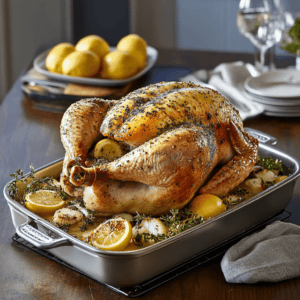When it comes to preparing a show-stopping turkey for your next big gathering, flavor and moisture are key. Unfortunately, traditional methods like rubs and marinades often fail to penetrate deeply into the meat, leaving the inner portions bland and dry. Enter the turkey injection recipe—a game-changing method that ensures every bite of your turkey is as flavorful and juicy as the last. In this comprehensive guide, we’ll explore everything you need to know about turkey injection recipes, from their benefits and variations to expert tips and frequently asked questions.
What is a Turkey Injection Recipe?
A turkey injection recipe involves creating a flavorful liquid mixture, often made with ingredients like broth, melted butter, fresh herbs, and spices. This mixture is then injected directly into the turkey’s meat using a meat injector, a syringe-like tool designed for this purpose. Unlike marinades or dry rubs, which primarily season the surface of the bird, the injection method delivers flavor deep into the muscle tissue. This ensures that the entire turkey is evenly seasoned, resulting in a moist, tender, and delicious dish with enhanced flavor in every bite.
Why Use an Injection Recipe for Turkey?
There are many reasons why injecting your turkey is a superior method for seasoning:
- Enhanced Flavor: Injection provides a method for evenly distributing seasonings throughout the meat, ensuring that every bite is infused with rich and consistent flavor. This technique enhances the overall taste and juiciness of the dish, creating a delicious and satisfying result.
- Increased Moisture: The injected liquid plays a crucial role in retaining moisture within the turkey, helping to prevent it from drying out during the cooking process. This ensures a juicy, tender result that enhances the overall flavor and texture of the meat.
- Quicker Results: Unlike traditional marination, which often requires several hours or even days to infuse flavors, injecting provides instant flavoring by delivering the seasoning deep into the meat. This method significantly reduces preparation time, requiring little to no resting period while still achieving a flavorful and juicy result.
Key Ingredients for a Turkey Injection Recipe
To craft a successful turkey injection recipe, you’ll need to choose ingredients that complement the natural taste of turkey. Here are some staples:
- Liquids:
- Chicken or turkey broth: Adds depth of flavor.
- Melted butter: Provides richness and enhances browning.
- Citrus juice: Brightens the flavor profile (e.g., lemon or orange juice).
- Herbs and Spices:
- Fresh herbs like rosemary, thyme, and sage.
- Ground spices such as garlic powder, paprika, and cayenne for a kick.
- Other Additives:
- Soy sauce or Worcestershire sauce for umami.
- Honey or maple syrup for a touch of sweetness.
Types of Turkey Injection Recipes
Different flavor profiles suit different occasions. Here are some popular variations:
- Butter-Based Recipes:
- Melted butter, combined with garlic and fresh herbs, creates a rich and classic flavor profile that complements roasted turkey perfectly. This blend enhances the natural taste of the meat, adding depth and a savory, aromatic touch to every bite.
- Cajun-Style Recipes:
- A blend of chicken broth, paprika, cayenne pepper, onion powder, and hot sauce creates a bold and spicy flavor that adds a fiery kick to your dish. This combination infuses the meat with robust seasoning, perfect for those who enjoy a touch of heat in their meals.
- Herb-Infused Recipes:
- A blend of fresh rosemary, sage, and thyme mixed with olive oil creates a fragrant and earthy flavor profile. This combination enhances the natural taste of the meat, adding a herbal, aromatic touch that is both subtle and delicious.
- Savory and Sweet Recipes:
- Combining apple cider, maple syrup, and a hint of cinnamon creates a delightful blend of sweet and savory flavors, perfect for a festive holiday treat. This combination adds a warm, comforting touch that enhances the dish with seasonal charm and richness.
Preparing the Turkey for Injection
Proper preparation is essential for a successful injection process that maximizes the flavor of the meat. Start by thoroughly cleaning your tools to ensure safety and hygiene. Next, carefully select or prepare a marinade that complements your dish, using a balance of flavors that will enhance the meat. Planning the injection technique, including evenly spacing the injection points, ensures the marinade is distributed throughout the meat for consistent seasoning. With these steps, you’ll achieve a tender, juicy, and flavorful dish that is sure to impress.
Selecting the Right Turkey
- Choose either fresh turkeys or those that have been frozen and properly thawed for the best results. Avoid pre-brined or self-basting turkeys, as they already contain added solutions that can alter the flavor balance and may interfere with the injection process, potentially leading to an overly salty or unevenly seasoned dish.
Cleaning and Prepping the Turkey
- Remove the giblets and neck from the cavity.
- Rinse the turkey under cold water and pat it dry with paper towels.
Preparing Injection Tools
- Use a high-quality stainless steel injector for durability and precision.
- Clean the injector thoroughly before use to ensure no contamination.
Step-by-Step Turkey Injection Guide
1. Create the Injection Mixture
- Combine your selected ingredients in a small saucepan and heat gently to allow the flavors to meld together. Once the mixture is well blended, strain it to remove any solids that could clog the meat injector, ensuring a smooth and easy injection process.
2. Fill the Injector
- Carefully draw the prepared mixture into the injector, making sure it is fully filled without any air bubbles. This ensures smooth injection and even distribution of the marinade throughout the meat.
3. Inject the Turkey
- Insert the needle deep into the turkey’s breast, thighs, and drumsticks, carefully injecting a small amount of the marinade in multiple spots. This technique ensures even distribution of the liquid, enhancing the flavor and moisture throughout the meat.
- Angle the needle slightly in different directions with each insertion to ensure the liquid is evenly distributed throughout the meat. This technique helps achieve a well-seasoned and flavorful result in every bite.
4. Pat the Turkey Dry
- After injecting the turkey, pat it dry once more to remove any excess surface liquid. This step is particularly important if you intend to apply a dry rub, as it helps the seasoning adhere better and ensures a flavorful, evenly coated turkey.
Cooking Your Injected Turkey
Once your turkey is injected, the cooking method can significantly impact the final results. Here are three popular methods:
- Roasting:
- Preheat the oven to 325°F (165°C).
- Roast the turkey breast-side up on a rack in a roasting pan, basting occasionally with pan drippings.
- Smoking:
- Set your smoker to 225°F (110°C) and use wood chips like hickory or applewood for added flavor.
- Smoke the turkey low and slow for optimal tenderness.
- Frying:
- Heat peanut oil to 350°F (175°C) in a deep fryer.
- Lower the turkey carefully into the oil and fry for about 3–4 minutes per pound.
Tips for Choosing the Right Injection Flavor
- Seasonal Themes: Select flavors that complement the season or occasion, such as bright citrus and rosemary for a fresh, spring-inspired dish, or the warm, comforting combination of apple cider and cinnamon for a cozy fall meal. Tailoring flavors to the time of year adds a thoughtful touch to your cooking and enhances the overall dining experience.
- Balance Bold vs. Mild Flavors: Make sure your chosen ingredients enhance the natural flavor of the turkey rather than overpowering it. A well-balanced blend of seasonings and marinades will highlight the turkey’s taste, creating a harmonious and delicious dish.
- Consider Dietary Preferences: Tailor your recipes to accommodate guests with specific dietary restrictions, such as using low-sodium broth for those watching their salt intake or opting for dairy-free alternatives to suit lactose-intolerant individuals. These adjustments ensure everyone can enjoy the meal without compromising on flavor or inclusivity.
How Long Should You Marinate After Injecting?
While injection recipes deliver immediate flavor to the meat, letting the turkey rest for 1–2 hours before cooking can greatly enhance the final result. This resting period allows the marinade to distribute more evenly, ensuring that every bite is flavorful and well-seasoned. The time also helps the meat absorb the liquid more effectively, contributing to a tender and juicy texture. However, if you’re on a tight schedule, you can cook the turkey immediately after injecting. While it may not achieve the same depth of flavor as a longer rest, the injection process still guarantees a delicious, moist, and flavorful turkey that is sure to impress.
Tools Needed for a Turkey Injection Recipe
- Injector: Select a durable meat injector that comes with multiple needle sizes. This versatility allows you to handle various types of marinades and cuts of meat efficiently, ensuring reliable performance and optimal flavor distribution.
- Mixing Bowl or Saucepan: For preparing the injection mixture, start by selecting fresh, high-quality ingredients that complement the dish. Combine them in a small saucepan and gently heat to meld the flavors. Strain the mixture to remove any solids, ensuring a smooth consistency that will easily flow through the meat injector without clogging.
- Meat Thermometer: Ensure the turkey is cooked to a safe internal temperature, with the breast reaching 165°F and the thighs reaching 175°F. Use a meat thermometer to check these temperatures accurately, ensuring the turkey is both safe to eat and perfectly cooked.
Turkey Injection Recipe Variations from Around the World
- Mediterranean Style:
- Olive oil, garlic, oregano, lemon juice, and sun-dried tomatoes.
- Asian-Inspired:
- Soy sauce, sesame oil, ginger, and a touch of honey.
- Traditional American:
- Butter, chicken stock, sage, and black pepper.
Common Mistakes and How to Avoid Them
- Over-Injecting:
- Inject just enough to enhance flavor without overfilling, which can cause uneven cooking.
- Using Low-Quality Ingredients:
- Opt for fresh herbs and high-quality broth for the best results.
- Neglecting Proper Cooking Techniques:
- Always monitor internal temperatures to avoid undercooking or overcooking.
How to Store and Reuse Leftover Injection Mixtures
Safe Storage Practices
- Store leftover mixtures in an airtight container in the refrigerator for up to 3 days.
Creative Ideas for Leftovers
- Use as a basting liquid during roasting.
- Add to soups, gravies, or sauces for extra flavor.
FAQs About Turkey Injection Recipes
- Can I use a turkey injection recipe on other meats?
Yes! Injection recipes are highly versatile and work wonderfully on chicken, pork, and beef, enhancing their flavor and juiciness with every bite. - How do I know if I’ve injected enough mixture?
Inject the marinade until the meat feels slightly firmer, ensuring it absorbs the flavors without becoming overly swollen or saturated. This balance helps achieve a flavorful and moist turkey without compromising its texture. - Do turkey injection recipes make a big difference in taste?
Absolutely! Injectors enhance both the flavor and moisture of the turkey, elevating its taste and ensuring a juicy, tender result that sets your dish apart from the rest. - What is the best injector for home cooks?
Stainless steel injectors with multiple needles are the ideal choice for versatility, allowing you to evenly distribute marinades or seasonings throughout the meat. Their durable construction ensures longevity, while the variety of needle options makes them suitable for different types of meats and marinades. - Can I skip marination if I inject the turkey?
Yes, injecting turkey minimizes the need for extended marination, as the flavors are delivered directly into the meat. However, allowing the turkey to rest after injection can further enhance the flavor by giving the seasonings more time to distribute evenly throughout the meat. - Are there any health concerns with injected turkey?
As long as your tools and ingredients are properly cleaned and handled, injected turkey is completely safe to prepare and enjoy. Ensuring cleanliness reduces the risk of contamination, making the process both safe and effective for enhancing the flavor and juiciness of the turkey.
Conclusion
Injecting your turkey is a surefire way to elevate its flavor, moisture, and overall appeal. Whether it’s for a holiday gathering or a special occasion, mastering this technique will leave your guests raving about your culinary skills. With the tips, recipes, and insights shared in this guide, you’re well-equipped to prepare the most flavorful turkey of your life. Happy cooking!
Related article:
How to make chicken of the woods more tender?
How Much is a Pound of Chicken of the Woods Worth?
Chicken of the Woods Recipe: A Step-by-Step Guide to Cooking This Wild Mushroom Delight



